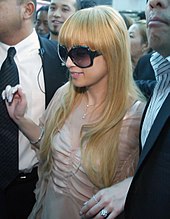Gyaru
Gyaru ( jap. ギ ャ ル ) is the Japanese transliteration of the English word gal ( phonetic spelling : / gæl /), which means "young woman" and is related to girl (/ gəːrl / jap. ガ ー ル , gāru ). Gyaru refers to fashion-conscious young women or representatives of a Gyaru-specific fashion type, whereby school girls in particular with this style are referred to as Kogyaru .
The word spread in the 1970s, but as fashion changed, so did the meaning of the word gyaru. The features of gyaru fashion are eye-catching makeup and hairstyle.
In recent years, the Japanese government has promoted gyaru culture as a new export product, and the Ministry of Foreign Affairs supports fashion shows to showcase the kawaii culture.
Subcategories of Gyaru styles
Gyaru-kei ( ギ ャ ル 系 )
This is the standard gyaru style or a collective term ( -kei ) for the various gyaru styles.
Yamamba ( ヤ マ ン バ )
Yamamba was in vogue from the 1990s to the early 2000s. The name comes from the Yamamba from Japanese folk tales, which are something like mountain witches with long white hair. Like Ganguro, the Yamamba have deeply tanned skin, their make-up is very thick, and they bleach their hair. In addition, the lipstick and eyeliner in white form a strong contrast with the brown skin.
Mamba ( マ ン バ )
Mamba was fashionable in the 2000s. It is similar to the Yamamba style, but the skin is darker and the make-up is more noticeable than that of the Yamamba style. In addition, the face is completely painted. Bright colors or eye-catching patterns are preferred for clothing fashions.
Hime-Gyaru ( 姫 ギ ャ ル )
Also known as Hime-kei ( 姫 系 , "princess style") and inspired by Rococo fashion. The devotees wear dresses or skirts in pink or other pastel colors with lots of lace and tulle like in rococo dress fashion . The hair is bleached or curled. The makeup style is the same as that of the standard gyaru.
Shiro-Gyaru ( 白 ギ ャ ル )
Shiro-Gyaru was popularized by Ayumi Hamasaki in the 2000s and is characterized by white ( shiro ) skin and bleached hair.
Onē-Gyaru ( お 姉 ギ ャ ル ) / One-Gyaru ( オ ネ ギ ャ ル )
Onē-Gyaru was also fashionable in the 2000s. Onē means “older sister” and the style is accordingly more ladylike and less flashy or eccentric.
Age-jō (age 嬢 )
Age-jō was in fashion from 2006. Age-jō refers to the special models depicted in the fashion magazine Koakuma Ageha ( 小 悪 魔 ageha) and their style Ageha-kei (ageha 系 ), which combines the gyaru look with that of nightclub hostesses. The basic hairstyles are updos and curls.
Neo-Gyaru ( ネ オ ギ ャ ル )
Since 2010, the Gyaru fashion style has been losing popularity and the trend has been to imitate a European-American look. Neo-Gyaru are characterized by the mixture of Western and Gyaru modes. The make-up style is dark lipstick and thick “European-American” eyebrows.





